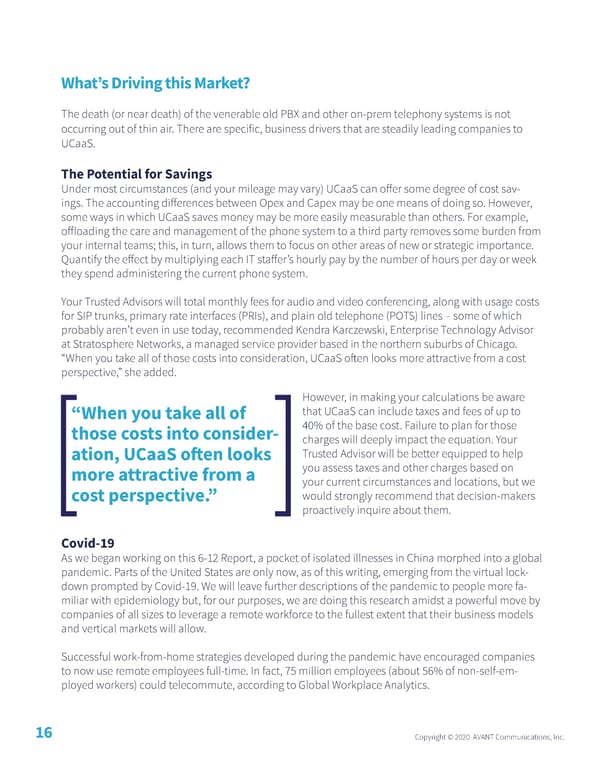What’s Driving this Market? The death (or near death) of the venerable old PBX and other on-prem telephony systems is not occurring out of thin air. There are specific, business drivers that are steadily leading companies to UCaaS. The Potential for Savings Under most circumstances (and your mileage may vary) UCaaS can offer some degree of cost sav- ings. The accounting differences between Opex and Capex may be one means of doing so. However, some ways in which UCaaS saves money may be more easily measurable than others. For example, offloading the care and management of the phone system to a third party removes some burden from your internal teams; this, in turn, allows them to focus on other areas of new or strategic importance. Quantify the effect by multiplying each IT staffer’s hourly pay by the number of hours per day or week they spend administering the current phone system. Your Trusted Advisors will total monthly fees for audio and video conferencing, along with usage costs for SIP trunks, primary rate interfaces (PRIs), and plain old telephone (POTS) lines – some of which probably aren’t even in use today, recommended Kendra Karczewski, Enterprise Technology Advisor at Stratosphere Networks, a managed service provider based in the northern suburbs of Chicago. “When you take all of those costs into consideration, UCaaS often looks more attractive from a cost perspective,” she added. However, in making your calculations be aware “When you take all of that UCaaS can include taxes and fees of up to those costs into consider- 40% of the base cost. Failure to plan for those charges will deeply impact the equation. Your ation, UCaaS often looks Trusted Advisor will be better equipped to help more attractive from a you assess taxes and other charges based on your current circumstances and locations, but we cost perspective.” would strongly recommend that decision-makers proactively inquire about them. Covid-19 As we began working on this 6-12 Report, a pocket of isolated illnesses in China morphed into a global pandemic. Parts of the United States are only now, as of this writing, emerging from the virtual lock- down prompted by Covid-19. We will leave further descriptions of the pandemic to people more fa- miliar with epidemiology but, for our purposes, we are doing this research amidst a powerful move by companies of all sizes to leverage a remote workforce to the fullest extent that their business models and vertical markets will allow. Successful work-from-home strategies developed during the pandemic have encouraged companies to now use remote employees full-time. In fact, 75 million employees (about 56% of non-self-em- ployed workers) could telecommute, according to Global Workplace Analytics. 16 Copyright © 2020 AVANT Communications, Inc.
 UCaaS trends Page 17 Page 19
UCaaS trends Page 17 Page 19